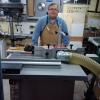I've been thinking for a while now about the feasibility of making my own wood flooring from rough lumber. I would just start off with a small room, like my master bath which is maybe 40 square feet, in order to get the hang of it. What are the guidelines for how wide the tongue & groove are? are the tongue & groove exactly centered in the board or are they offset a little to allow for more wood for future sanding and refinishing? what about those cuts in the bottom of the board?..
I've got a good source for air dried lumber at $0.80/BF for oak, cherry and others but I dont have a router table or spray equipment (maybe I have a good excuse to get those huh?). I would think for small jobs the T&G's could be cut on a table saw and I could brush on Waterlox Original for a finish.
What do you think? Thanks.






 Reply With Quote
Reply With Quote


